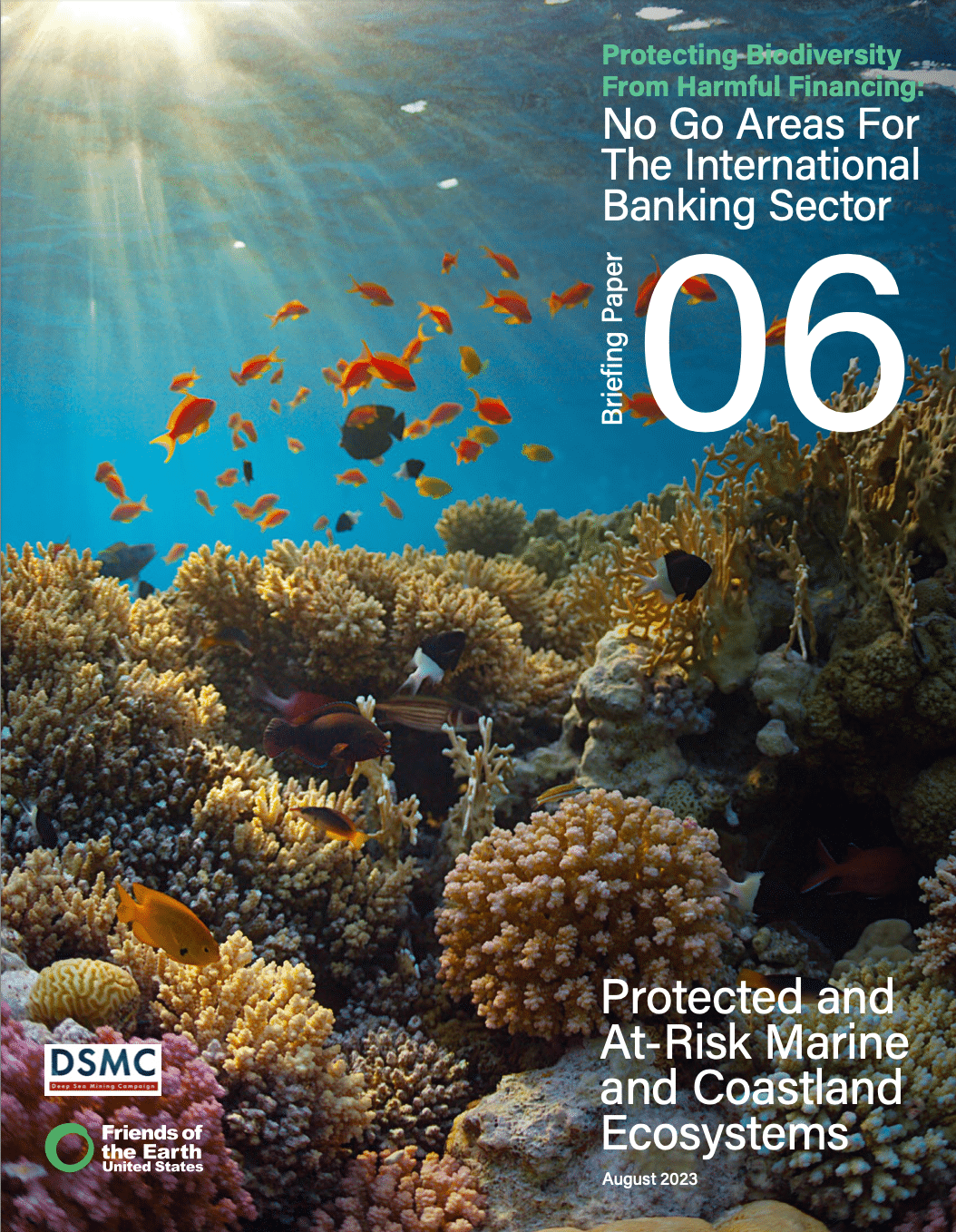- Home
- Sustainable Economic Systems
- Environmental & Social Standards
- Protected and At-Risk Marine and Coastal Ecosystems
Protected and At-Risk Marine and Coastal Ecosystems
New briefing paper calls on banks and financiers to prohibit harmful financing to protected or at-risk marine or coastland ecosystems
Friends of the Earth US and the Deep Sea Mining Campaign have co-published a new briefing paper, “Protecting biodiversity from harmful financing: Protected or at-risk marine or coastland ecosystems.” In recognition of World’s Indigenous Peoples Day, the briefing paper explains why it is crucial for banks and financiers to prohibit direct and indirect financing to harmful activities which negatively impact marine and coastland ecosystems and the Indigenous and local communities that depend on them.
Marine and coastland areas are crucial for sustaining biodiversity, regulating the climate, and preserving Indigenous and community livelihoods, sustaining a multitude of resources and cultural significance to Indigenous Peoples and local communities worldwide.
However, harmful bank financed activities are threatening protected and at-risk marine and coastland ecosystems. This includes ongoing financial support to the fossil fuel industry, mining, and illegal fishing, as well as emerging new threats, such as deep sea mining and tailings disposal.
The paper offers key takeaways on how the international banking sector can strengthen policies in order to fully protect at-risk and protected marine and coastland ecosystems and respect the rights of Indigenous Peoples and local communities.
Key takeaways of this paper include:
- Banks and financiers should strengthen protections for protected or at-risk marine or coastland ecosystems and prohibit harmful financing impacting these areas. The Banks and Biodiversity Initiative encourages banks and financiers to draw from our proposed definition of such ecosystems: “protected or at-risk marine or coastland ecosystems, include mangrove forests, wetlands, reef systems, and those located in formally, informally, or traditionally held areas, Indigenous Territories (ITs), or public lands not yet demarcated, or Indigenous and Community Conserved Areas (ICCA).”
- The international banking sector writ large has yet to fully develop protections on marine and coastland areas.
- Banks and financiers should draw from existing international frameworks in order to identify, prioritize, and protect protected and at-risk marine and coastland areas.
- Banks and financiers should take a precautionary approach to deep sea mining, and establish a moratorium on financing deep sea mining unless the risks of mining are comprehensively understood and effective protection can be ensured, and that mechanisms are in place to consult with the public throughout decision-making.
- Banks and financiers should prohibit financing to the expansion, extraction, and shipping of fossil fuels.
- Banks and financiers should conduct stronger due diligence for land-based activities which may have significant marine and coastland impacts, and require relevant, accurate, robust assessments on such impacts. These include associated infrastructure and indirect impacts of fossil fuel, mining, and other similar extractive activities in coastal areas, such as ports, shipping traffic, pollution, noise pollution, etc.
- Banks and financiers should consider how their financing decisions may preclude financing in more sustainable development pathways. For instance, financing harmful, high-risk sectors, such as fossil fuels, often precludes financing sustainable alternatives, especially in coastal areas with high tourism potential or biodiversity value.
- Banks and financiers would benefit from improving or establishing strong Indigenous Peoples policies which protect the right to self-determination, sovereignty, and free, prior, informed consent.
- Banks and financiers should require free, prior, informed consent as a right to Indigenous Peoples, and as a best practice for consulting local communities.
- Projects and activities that harm biodiversity and Indigenous communities face potential legal and financial liabilities, making them risky investments for banks.
This paper is part of Friends of the Earth US’ new “Protecting Biodiversity from Harmful Financing” briefing paper series, which underscores why banks and financiers should exclude harmful, unsustainable financing to activities and projects which impact critical, at-risk ecosystems.
Each briefing paper is dedicated to a key area as identified by the Banks and Biodiversity Initiative’s eight proposed No Go Areas. This paper is about protected or at-risk marine and coastland ecosystems, which is paper 06 of the series.
Full briefing paper series include:
- No Go area 1: Internationally recognized areas
- No Go area 2: Nationally recognized areas
- No Go area 3: Key Biodiversity Areas and habitats with endangered and endemic species
- No Go area 4: Primary and vulnerable secondary forests
- No Go area 5: Free flowing rivers
- No Go area 6: Protected or at-risk marine and coastland ecosystems
- No Go area 7: Areas where Free, Prior and Informed Consent has not been obtained by Indigenous Peoples and local communities
- No Go area 8: Iconic, transboundary ecosystems
Friends of the Earth US is part of the Banks and Biodiversity Initiative, a civil society coalition which advocates that banks and financiers strengthen their biodiversity policies and practices in order to halt and reverse biodiversity loss. Learn more at banksandbiodiversity.org.

